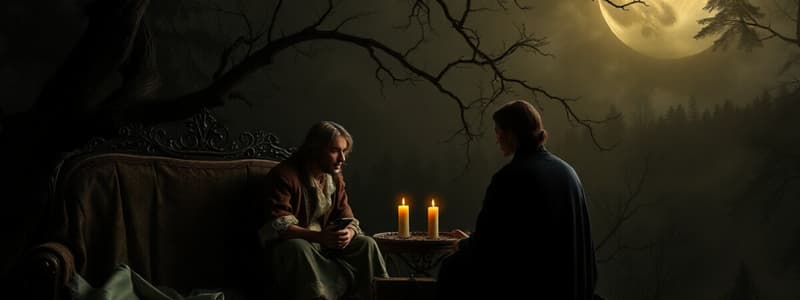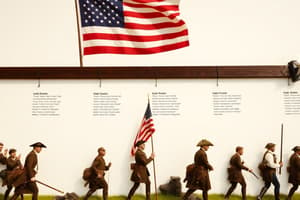Podcast
Questions and Answers
Which theme is NOT commonly associated with American Romanticism?
Which theme is NOT commonly associated with American Romanticism?
- Emphasis on individualism
- Emotion over reason
- Strict adherence to tradition (correct)
- Devotion to beauty
Dark Romanticism presents individuals as inherently good and successful.
Dark Romanticism presents individuals as inherently good and successful.
False (B)
Name one author associated with Transcendentalism.
Name one author associated with Transcendentalism.
Ralph Waldo Emerson or Henry David Thoreau
The five pillars of Transcendentalism include self-reliance, free thought, importance of nature, non-conformity, and _____
The five pillars of Transcendentalism include self-reliance, free thought, importance of nature, non-conformity, and _____
Match the literary movement to its characteristic theme:
Match the literary movement to its characteristic theme:
Which of the following authors is associated with the themes of freedom, racism, and identity?
Which of the following authors is associated with the themes of freedom, racism, and identity?
Edgar Allan Poe's most notable works were characterized by their length and complexity.
Edgar Allan Poe's most notable works were characterized by their length and complexity.
What did Ralph Waldo Emerson reject after his wife's death?
What did Ralph Waldo Emerson reject after his wife's death?
Emily Dickinson's poetry often explores her fascination with __________.
Emily Dickinson's poetry often explores her fascination with __________.
Match the authors with their notable works:
Match the authors with their notable works:
Which author is known for living in a small home by a lake for two years?
Which author is known for living in a small home by a lake for two years?
Nathaniel Hawthorne was proud of his ancestry linked to the Salem witch trials.
Nathaniel Hawthorne was proud of his ancestry linked to the Salem witch trials.
Who inspired Ralph Waldo Emerson's work?
Who inspired Ralph Waldo Emerson's work?
Edgar Allan Poe's famous symbols include the __________ and the beating heart.
Edgar Allan Poe's famous symbols include the __________ and the beating heart.
What is one of the primary themes in Nathaniel Hawthorne's works?
What is one of the primary themes in Nathaniel Hawthorne's works?
Flashcards
Romanticism
Romanticism
A literary movement emphasizing individualism, imagination, and idealism. It often explored distant times and places, highlighting moral issues, emotion, and creativity.
Transcendentalism
Transcendentalism
A philosophical movement valuing nature, spiritual unity, and inherent human goodness. It emphasized self-reliance, free thought, and non-conformity, believing in the transformative power of the individual.
Dark Romanticism
Dark Romanticism
A literary movement that explored the darker aspects of human nature and the natural world. It often depicted characters prone to sin and self-destruction, emphasizing themes of terror, decay, and the search for identity.
What is the common theme?
What is the common theme?
Signup and view all the flashcards
What did the American Renaissance represent?
What did the American Renaissance represent?
Signup and view all the flashcards
Emily Dickinson's Poetry
Emily Dickinson's Poetry
Signup and view all the flashcards
Dickinson's Use of Uppercase
Dickinson's Use of Uppercase
Signup and view all the flashcards
What is the meaning of 'I cannot stop for death'?
What is the meaning of 'I cannot stop for death'?
Signup and view all the flashcards
Washington Irving's Writing Style
Washington Irving's Writing Style
Signup and view all the flashcards
Ralph Waldo Emerson's Beliefs
Ralph Waldo Emerson's Beliefs
Signup and view all the flashcards
Henry David Thoreau and 'Walden'
Henry David Thoreau and 'Walden'
Signup and view all the flashcards
What did Dickinson rebel against?
What did Dickinson rebel against?
Signup and view all the flashcards
What's a key element of Dickinson's poetry?
What's a key element of Dickinson's poetry?
Signup and view all the flashcards
What's special about Dickinson's punctuation?
What's special about Dickinson's punctuation?
Signup and view all the flashcards
Why is Dickinson's Uppercase unique?
Why is Dickinson's Uppercase unique?
Signup and view all the flashcards
What kind of writer was Irving?
What kind of writer was Irving?
Signup and view all the flashcards
Who inspired Emerson?
Who inspired Emerson?
Signup and view all the flashcards
What did Emerson believe about nature?
What did Emerson believe about nature?
Signup and view all the flashcards
What did Thoreau value?
What did Thoreau value?
Signup and view all the flashcards
What's a key feature of Poe's writing?
What's a key feature of Poe's writing?
Signup and view all the flashcards
Why is Poe's style unique?
Why is Poe's style unique?
Signup and view all the flashcards
Study Notes
American Renaissance (1828-1865)
- Characterized by renewed national pride and advocacy for freedoms.
- Considered the pinnacle of American literature.
Romanticism
- Emphasized individualism, idealism, imagination, and emotion.
- Often explored distant times and places, embodying American identity.
- Themes included moral issues, emotional expression, creativity, rejection of tradition.
- Focus on freedom from rules, solitary life, imagination over reason, beauty and nature.
- Key authors included Emily Dickinson and Washington Irving.
Dark Romanticism/American Gothic
- Depicted humans as prone to sin and self-destruction.
- Viewed nature as dark, decaying, and mysterious.
- Showed characters facing failures.
- Used supernatural elements, haunted settings, and identity crises to inspire terror and explore psychology.
- Key authors included Edgar Allan Poe and Nathaniel Hawthorne.
Transcendentalism
- Valued nature and spiritual unity of all life (humans, nature, God).
- Believed in inherent goodness of humans.
- Saw God as central to the universe.
- Authors grouped by similar content, not necessarily writing style.
- Key principles: self-reliance, free thought, nature's importance, non-conformity, confidence.
- Key authors included Ralph Waldo Emerson and Henry David Thoreau.
Emily Dickinson
- Highly educated, yet challenged religious norms.
- Obsessed with death and the afterlife, exploring both positive and negative human emotions.
- Used biblical allusions, capitalized common nouns, dense metaphors, and unique punctuation (excessive dashes).
- Refused the idea of heaven.
- Focused on symbolism, allegory, and significance in thoughts.
- Notably, she was known as a recluse.
Washington Irving
- Scottish/English immigrant parents.
- Created "The Sketch Book of Geoffrey Crayon, Gent," which contained stories & essays.
- Known for "Rip Van Winkle" and "The Legend of Sleepy Hollow."
- Early American fairy tale writer.
- Advocated for stronger copyright laws.
- Characterized by imaginative, descriptive writing with humor and satire.
Ralph Waldo Emerson
- Son of a priest, educated at Harvard, and ordained as a priest before rejecting his profession.
- Influenced by Mary Moody Emerson.
- Rejected cultural traditions.
- Left the church after his wife’s death, experiencing European travel and zoo experiences.
- Believed nature is within us.
- Criticized poets as boring and dry.
- Celebrated American uniqueness and originality.
- Advocated for self-reliance and rejection of past traditions, urging adherence to nature rather than social conventions.
- Embraced pantheism.
Henry David Thoreau
- Friend of Ralph Waldo Emerson.
- Lived at Walden Pond for 2 years.
- Emphasized self-reliance and distrust of an overly modernized society.
- Admired solitary living, learning from the introspection.
- Believed in unity with nature, recognizing cyclical connections.
- Wrote "Walden, or "Life in the Woods"
Edgar Allan Poe
- Parents were actors, both died when he was young, sent to live with a tobacco farmer.
- Struggled with finances, substance use, and grief throughout life.
- Served in the military.
- Published poems, critiqued as a writer.
- Known for brevity, musicality, allegories, repetition, rhyme, and alliteration.
- Tragically lost his wife, Virginia, and experienced personal hardship.
- Disappeared before marriage, found dead at 40.
- Famous for use of symbols like the raven.
Nathaniel Hawthorne
- Descendent of Salem witch trial judge.
- Wrote The Scarlet Letter and Twice Told Tales.
- Explored themes of sin, guilt, morality, and human psyche.
- Idealist with interests in transcendentalism.
Studying That Suits You
Use AI to generate personalized quizzes and flashcards to suit your learning preferences.




